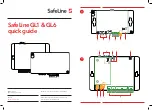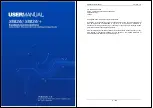
ais transmission up
To configure Alarm Indication Signal (AIS) transmission on a Connectivity Fault Management (CFM) interface,
use the
ais transmission up
command in interface CFM configuration mode. To disable AIS transmission
on an interface, use the no form of this command.
ais transmission up
[
interval 1s| 1m
] [
cos cos
]
no ais transmission up
[
interval 1s| 1m
] [
cos cos
]
Syntax Description
(Optional) Interval at which AIS packets are transmitted. Valid values are:
•
1s
–
Interval of 1 second
•
1m
–
Interval of 1 minute
interval
(Optional) Specifies the Class of Service (CoS) for the AIS packets. Valid values
are 0 to 7.
cos cos
Command Default
AIS transmission is disabled by default.
If
interval
is not specified, the default interval is 1 second.
IF
cos
is not specified, each MEP uses its own CoS value, inherited from the interface.
Command Modes
Interface CFM configuration (config-if-cfm)
Command History
Modification
Release
This command was introduced.
Release 3.9.1
Usage Guidelines
To use this command, you must be in a user group associated with a task group that includes appropriate task
IDs. If the user group assignment is preventing you from using a command, contact your AAA administrator
for assistance.
AIS transmission packets for CFM can be configured only on interfaces with no down MEPs. AIS packets
are transmitted only if a MIP exists on the interface and the line protocol state is down. AIS messages are
transmitted up, toward the bridging function (same direction as an up MEP sends CCMs), and they are
transmitted at the level of the MIP.
If AIS transmission is configured on an interface with any down MEPs, the configuration is ignored, and an
error is displayed in the
show ethernet cfm configuration-errors
command.
Cisco ASR 9000 Series Aggregation Services Router Interface and Hardware Component Command Reference,
Release 5.3.x
159
Ethernet OAM Commands on the Cisco ASR 9000 Series Router
ais transmission up
















































